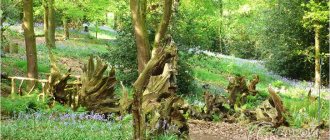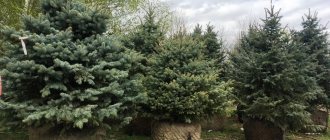Author: Elena N. https://floristics.info/ru/index.php?option=com_contact&view=contact&id=19 Category: Garden plants Published: December 22, 2018Last edits: April 15, 2021
- Rules of care
- Bryozoan (Sagina saginoides)
Bryozoan (lat. Sagina) is a genus of flowering plants of the Carnation family, which includes 20-30 species growing in the Northern Hemisphere, although some bryozoans can be found further south. The Latin name of the genus means “feed”: one of the representatives of the genus was intended for fattening pigs.
Planting and caring for bryozoans
- Planting: sowing seeds for seedlings - at the end of March or early April, transplanting seedlings into the ground - in mid-May.
- Flowering: throughout the summer.
- Lighting: bright sunlight.
- Soil: loamy and sandy loam.
- Watering: regular, evening, preferably by sprinkling. After planting the seedlings in the ground - daily, but as soon as they take root, they switch to watering 2-3 times a week.
- Feeding: nitrogen fertilizer - in early spring and early summer, phosphorus and potassium fertilizer - in early spring, summer and autumn.
- Reproduction: seeds, sods.
- Diseases: fungal infections.
- Pests: aphids.
Read more about growing bryozoans below.
Botanical description
Bryozoans are low herbaceous annuals or perennials up to 20 cm high with ascending, erect or recumbent stems forming sods. The stems contain narrow linear leaves up to 1.5 mm wide, merging at the base into a short sheath. Small white bisexual flowers up to 10 mm in diameter, solitary or collected in few-flowered inflorescences, are located on long pedicels. The fruit of the bryozoan is an oblong capsule with kidney-shaped seeds.
The most commonly cultivated species are bryozoan awl-shaped, or Irish moss. It is the planting and care of the awl-shaped bryozoan that forms the basis of this article.
Reviews from gardeners
Irish moss looks very good in flower beds, and is especially practical as a border for a flower bed. Feels good next to succulents (Victoria, Yekaterinburg).
We decorated a children's playground and the children really liked it. The moss is very soft, you can run barefoot. Well suited for playing, you don’t have to be afraid that children will fall and get hurt, besides, the very fresh green color is pleasantly pleasing to the eye all year round (Elena, Nizhny Novgorod)
Of course, you can use moss for the lawn, but the surface is uneven and wavy. You can walk, but it is inconvenient to run, unless you use the lawn for decorative purposes. But this is not very practical (Vladimir, Chelyabinsk).
I tried to grow Irish moss on my property. Very attractive appearance, similar to a soft green carpet. Growing and care are not difficult (Tatyana, Krasnoyarsk)
0
( 19 ratings, average: 4.26 out of 5)
Back
Do-it-yourself patio at your summer cottage
MORE
Growing bryozoans from seeds
Sowing seedlings
Bryozoans are grown from seeds, which can be purchased at a garden pavilion or flower shop. They are sown at the end of March or beginning of April on top of a moist substrate placed in containers, consisting of equal parts of leaf and turf soil. Cover the crops with film and place them under bright but diffused light. At a temperature of 25˚C, seedlings appear within a week, and only when the bryozoan subulate seedlings begin to germinate en masse will it be possible to remove the film from the crops.
- Sweet peas: growing from seeds in the garden
In the photo: Bryozoan moss
When the small green needles turn into tufts of bright green bristles, the seedlings are planted in larger containers or placed in separate pots.
When and how to plant
Bryozoan seedlings are planted in open ground in May, when warm weather sets in and the soil warms up well. The best place for bryozoans is an open sunny area, although Irish moss also grows in the shade, but then it forms less dense and dense cushions. The bryozoan prefers loamy or sandy soil.
How to plant and grow sedum on a plot
In heavy soil, before planting the seedlings, you need to add sand for digging. If the soil is suitable for growing bryozoans, you should definitely loosen it well to a depth of 10 cm, remove weeds and plant remains of the previous crop and level the surface of the area.
Seedlings are planted, keeping a distance of 5-10 cm between them. After planting, the area is watered.
Cultivation
Bryozoan is used in landscape design as an ornamental garden plant, which creates an effect of slight negligence and vintage on the site:
- on rocky terrain;
- in combination with stones;
- for framing artificial reservoirs, fountains, wells, flower beds and paths;
- in carpet compositions, in container plantings in recreation areas, in rock gardens and rockeries;
- between path slabs;
- as mulch in a flower bed with bulbous plants (retains moisture and prevents weeds from growing);
- for creating mountain landscape installations, Irish hills, fantasy mini-gardens in hard-to-reach corners of the garden;
- as a background for coniferous or succulent groups;
- like an imitation of moss thickets in a Japanese garden.
The low-growing, rapidly growing bryozoan subulate forms a beautiful lawn that does not require regular mowing. If it must be perfectly smooth, it is recommended to trample it down from time to time. The plant quickly remembers the shape that they try to give it. If you want to maintain the undulation of the bushes, you shouldn’t do this.
Sowing bryozoans in open ground
In areas with a warm climate, there is no point in wasting time growing seedlings: the seeds are sown directly into the ground. Planting of bryozoan awl-shaped is carried out before winter: simply scatter the seeds over the area, trying to distribute them evenly. When the snow begins to melt in the spring and saturate the soil with moisture, it will draw the seeds into the ground just as much as needed. The first bryozoan shoots will appear in mid-spring.
- How to sow cineraria seeds for seedlings (video)
Flaws
It is difficult to find disadvantages in the awl-shaped bryozoan. When you first meet, it seems that she is all nothing but merits. But not everything is so simple.
- Soil preparation
Before planting both seeds and seedlings, the soil requires careful preparation. It must first be drained and composted. Then prepare a suitable soil mixture, observing certain proportions. And also distribute it evenly over the area.
- Aggressiveness
Many people accuse the bryozoan of spreading across an area at the speed of light, filling all available space, like a weed. However, this disadvantage can and must be combated. First, choose varieties that have a slow growth rate. Secondly, this process can always be artificially stopped by sprinkling the root zone of the plant with gravel.
Another reason why bryozoans can take over the entire area is planting the wrong type. Subulate is easily confused with recumbent. The latter spreads like a weed and kills other more tender plants. She is completely unpretentious and requires no care. It is not grown as an ornamental grass, since it has an inexpressive appearance: it does not hold its shape, its greenery is pale green, its flowers are too small, its shoots are strongly curved, growing in a chaotic manner in different directions.
Caring for bryozoans in the garden
Rules of care
In order for your Irish moss lawn to look attractive, you will have to take care of it: water it, feed it, and on the eve of winter, if severe frosts are expected with little snow, cover the lawn with spruce branches. If the winter is frosty but snowy, the bryozoan will not need shelter. The plant does not need cutting.
How to grow loosestrife, incl. and coin
Watering and fertilizing
The main care for bryozoans is regular watering. The first two weeks after planting the seedlings in the ground, watering the lawn should be daily, but as soon as the seedlings take root and become stronger, watering is reduced: even in a prolonged drought, the bryozoan is watered no more than 2-3 times a week. The most suitable method for moistening a moss grass lawn is sprinkling.
And keep in mind that Irish moss growing in an open area can only be watered in the evening, otherwise the sun will burn the greenery.
In the photo: Bryozoan flowering
For normal growth and development, the bryozoan needs to be fed. Ammonium sulfate, which is necessary especially in the first year of a plant’s life, must be applied in an amount of 45 g/m² twice per season: in early spring and early summer. Three times a year - in early spring, summer and autumn - the soil on the site is fertilized with superphosphate at the rate of 16 g/m². Potassium, which stimulates the rapid growth of shoots and the development of cold resistance, also fertilizes the area three times per season at the rate of 10 g/m².
Pests and diseases
From excessive moisture, the bryozoan can be affected by fungal infections, which can be eliminated with the help of fungicidal drugs. However, first of all, you need to review the watering regime, otherwise a relapse of the disease is possible.
Bryozoans also have problems that are not related to infections: with a sudden strong cold snap, it can freeze, but if you feed the plant with phosphates on time and in sufficient quantities, this will help the bryozoan quickly adapt to temperature changes and not die.
- Causes of degeneration of gladioli
Growing bryozoans in moist clay soil, oversaturated with nitrogen fertilizers, can lead to the fact that the plant does not fall asleep and will continue to develop even under snow if it has fallen on still warm soil. As a result, the bryozoan may dry out.
In soil with high acidity and excess phosphorus, especially with excessive soil moisture, the plant may suffer from chlorosis: the leaves and stems of the bryozoan become pale yellow. You can cope with the problem by spraying the bryozoan with iron chelate.
Among the pests, the bryozoan can be attacked by green aphids, which are destroyed with an insecticide solution.
The benefits of Irish moss compared to regular lawn
Even novice gardeners can grow a lawn from bryozoan awl-shaped, and landscape designers are increasingly starting to figure it out in the creation of garden plantings.
Positive points:
- There is no need to mow such a lawn, since the shoots rise to a height of no more than 5-8 cm;
- You can walk and run on this surface barefoot, wearing shoes, and have picnics on it. A “serious football match” may leave damage, but within a short time it will be covered by grass even without human intervention. The shoots quickly take root, filling the bald spots;
- A dense carpet leaves no chance for weeds. If single specimens manage to get through, they are simply removed manually;
- The small surface area of the leaves minimizes moisture evaporation. Watering the lawn will only be necessary during the early stages of growth and during periods of severe, prolonged drought.
It will be a real disaster if you confuse the seeds and instead of the subulate bryozoan, sow the procumbent bryozoan, which is a weed.
Types and varieties
Bryozoan (Sagina saginoides)
Or the bryozoan , a slow-growing ground cover plant with a tap root system that forms carpets of dense cushions. The shoots of the bryozoan pressed to the ground are covered with small light green needle-shaped leaves. The plant blooms in early summer with a few white flowers.
In the photo: Bryozoan (Sagina saginoides)
Bryozoan (Sagina procumbens)
Or bryozoan midge - a widespread perennial from 2 to 10 cm in height with recumbent or slightly erect branched stems that easily take root at the nodes. Narrow-linear, sharp, fused base leaves of this species, from 2 to 10 mm long and up to 0.5 mm wide, are collected in multi-leaf rosettes. Generative and vegetative shoots extend from the leaf axils. Bisexual, small white flowers are located on thin long stalks.
In the photo: Bryozoan (Sagina procumbens)
Bryozoan subulata (Sagina subulata)
This is an evergreen perennial that forms small but thick cushions resembling moss, up to 8 cm high. The stems of the plant are creeping and branched, the leaves are small and opposite, the flowers are white, up to 5 mm in diameter. The awl-shaped bryozoan has been in culture since 1881. Along with the main species, plant varieties with yellow leaves are popular.
In the photo: Bryozoan subulata (Sagina subulata)











